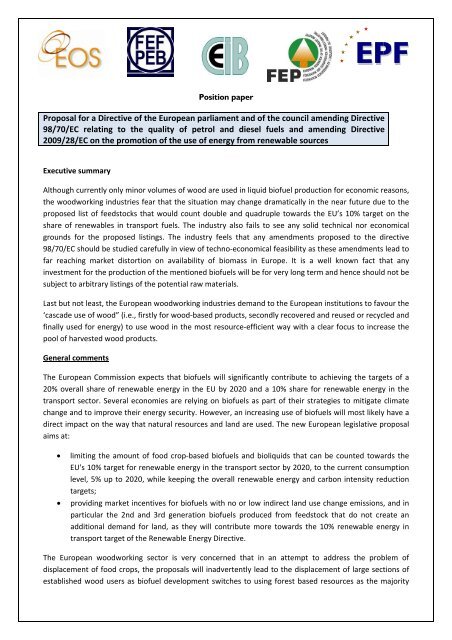EPF-EOS-FEP-FEFPEB-CEI-BOIS position paper - European Panel ...
EPF-EOS-FEP-FEFPEB-CEI-BOIS position paper - European Panel ...
EPF-EOS-FEP-FEFPEB-CEI-BOIS position paper - European Panel ...
- No tags were found...
You also want an ePaper? Increase the reach of your titles
YUMPU automatically turns print PDFs into web optimized ePapers that Google loves.
Position <strong>paper</strong>Proposal for a Directive of the <strong>European</strong> parliament and of the council amending Directive98/70/EC relating to the quality of petrol and diesel fuels and amending Directive2009/28/EC on the promotion of the use of energy from renewable sourcesExecutive summaryAlthough currently only minor volumes of wood are used in liquid biofuel production for economic reasons,the woodworking industries fear that the situation may change dramatically in the near future due to theproposed list of feedstocks that would count double and quadruple towards the EU’s 10% target on theshare of renewables in transport fuels. The industry also fails to see any solid technical nor economicalgrounds for the proposed listings. The industry feels that any amendments proposed to the directive98/70/EC should be studied carefully in view of techno‐economical feasibility as these amendments lead tofar reaching market distortion on availability of biomass in Europe. It is a well known fact that anyinvestment for the production of the mentioned biofuels will be for very long term and hence should not besubject to arbitrary listings of the potential raw materials.Last but not least, the <strong>European</strong> woodworking industries demand to the <strong>European</strong> institutions to favour the‘cascade use of wood” (i.e., firstly for wood‐based products, secondly recovered and reused or recycled andfinally used for energy) to use wood in the most resource‐efficient way with a clear focus to increase thepool of harvested wood products.General commentsThe <strong>European</strong> Commission expects that biofuels will significantly contribute to achieving the targets of a20% overall share of renewable energy in the EU by 2020 and a 10% share for renewable energy in thetransport sector. Several economies are relying on biofuels as part of their strategies to mitigate climatechange and to improve their energy security. However, an increasing use of biofuels will most likely have adirect impact on the way that natural resources and land are used. The new <strong>European</strong> legislative proposalaims at:limiting the amount of food crop‐based biofuels and bioliquids that can be counted towards theEU's 10% target for renewable energy in the transport sector by 2020, to the current consumptionlevel, 5% up to 2020, while keeping the overall renewable energy and carbon intensity reductiontargets;providing market incentives for biofuels with no or low indirect land use change emissions, and inparticular the 2nd and 3rd generation biofuels produced from feedstock that do not create anadditional demand for land, as they will contribute more towards the 10% renewable energy intransport target of the Renewable Energy Directive.The <strong>European</strong> woodworking sector is very concerned that in an attempt to address the problem ofdisplacement of food crops, the proposals will inadvertently lead to the displacement of large sections ofestablished wood users as biofuel development switches to using forest based resources as the majority
Position <strong>paper</strong>feedstock. It is essential to ensure that the biofuel production (as well the production of 2nd and 3rdgeneration biofuels) takes place in a sustainable way: the increase of the crops ‐ as well the increasedemand for woody sources ‐ shall not inadvertently and significantly have an impact on established woodusers. The final emissions of greenhouse gases linked to change in land use change may cancel, in whole orin part, the reductions of emissions related to the use of this kind of fuel. It should not be forgotten thatbiofuels include fuels derived from biomass conversion, as well as solid biomass as wood.The <strong>European</strong> Commission and the <strong>European</strong> Institutions should guarantee that the investments made inbiofuels production shall not result in the unintended consequence of releasing more carbon emissions dueto land‐use changes and do not hamper the availability of raw materials used in other industrial sectors(e.g. woodworking industries). The biofuels sustainability criteria, which are in force today, prevent thedirect conversion of forests and wetlands and areas with a high biodiversity value for biofuels production.Forestry derived small round wood, waste wood (reclaimed post‐consumer wood), residues and byproductsfrom wood processing are major raw material inputs into the panel and <strong>paper</strong> industries.Furthermore, small logs and the falling boards in sawmills are used by the wood packaging material andpallet industry and composite pallet block production. Subventions for use for biofuel and woodybiomass energy production should be permitted only when there is no other economically or industrialuse available for the side‐stream users.Wood sources account for half of the renewable energy in Europe and thus already play an important rolein meeting energy needs (Source: UNECE, The <strong>European</strong> Forest Sector Outlook Study II. 2010‐2030).Moreover the recent <strong>European</strong> study "EUwood" shows that wood consumption for energy generation isexpected to grow from 346 million solid cubic meters in 2010 (3.1 EJ) to 573 million cubic meters (5 EJ) in2020 and could reach 752 million cubic meters in 2030 (6.6 EJ). These results are based on the assumptionthat the share of wood in energy from renewable sources will decrease ‐ from 50% in 2008 to 40% in 2020.A deficit of 200 million m³ of wood is expected by 2025 and of 300 million m³ by 2030The <strong>European</strong> woodworking industries are not opposed per se to the use of wood as fuel, but areopposed to the provision of subventions that either directly or indirectly support the procurement of thefuel which in turn puts established wood processors and manufacturers at a competitive disadvantageand ultimately leads to a loss of investor confidence in such industries.Finally, the <strong>European</strong> woodworking industry urges to the <strong>European</strong> institutions to favour the ‘cascade useof wood” (i.e., firstly for wood‐based products, secondly recovered and reused or recycled and finally usedfor energy) in developing renewable energy policies taking into account the three pillars of sustainabledevelopment:‐ ‘planet’, where woodworking scores better than energy production, due to the fact that CO 2 isstored during the entire life of the wooden product, instead of released immediately;‐ ‘people’, where woodworking creates employment that is at least 25 times higher when comparing itto burning of the same amount of wood;‐ ‘profit’, where the added value generated by woodworking outperforms that of bio‐energy by afactor close to 10.





